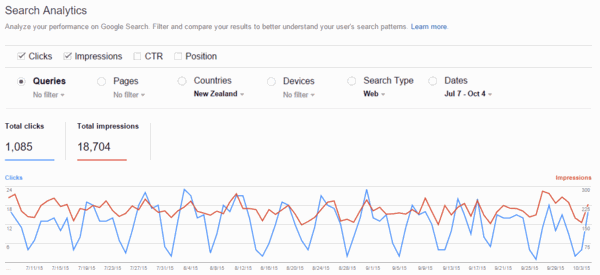
Measuring your organic market click share
Measuring your organic market click share
A lot of the time, we get clients who let us know what sorts of keyword they want to get rank in Google for. It’s great to know they have thought about performance goals for their website, but understanding how rank translates into business is a crucial step that has to be assessed as well. Here’s an example of why ranking for a few keyword phrases is just not enough:
Let’s say an accountancy business wants to rank for “accounting services Auckland”, because that’s what they do and where they are. They also want rank for “accountant Auckland”. Great stuff, these are probably two excellent keywords to show up for if you are an Auckland based accountant, but you need to do the math on both of these.
Now let’s say there are 100 searches per month for the first phrase, and 120 searches per month for the second. A total of 220 searches that they could get exposure for.
Now let’s say they manage to rank #1 in Google for both of these. They worked very hard to get to that position, did a lot of SEO work on their site, and invested a tidy sum in having an agency apply the SEO work for them.
This is starting to be an ROI (return on investment) exercise, but mainly I want to point out an important factor that might sway the way you think about keywords and rank.
If the business ranks #1 for 220 searches, then about 44 (est 20%) of the search traffic might consider clicking on the organic search results. The 20% figure varies wildly depending on who you talk to, plus whether there is a significant Google Adwords presence on the same page. This study (here) back in 2013 reported that as little as 6% click on paid ads in Google search. And this study (here) from 2014 suggested that Google Ads on the page could influence an increase or decrease in clicks based on position and co-presence of organic and paid results. For argument’s sake, I’ll stick with a 20% CTR figure for #1 rank. That means the business could get approximately 44 visits from these two keyword phrases.
Now let’s say they can convert around 2% of all website visitors into clients. That would give them about 11 new clients per year from these two keyword phrases. Is that enough? We don’t know without doing a whole CPA analysis, but here’s what I want to point out:
Getting #1 rank for both keyword phrases might get the business 11 new clients per annum, from a possible search volume of 220 per month x 12 months = 2640 searches. The final actual conversion figure is 11/2640 = 0.4%. Many business owners imagine they will convert as much as 50% of the search volume from being on position 1. There’s clearly some discrepancy here. Am I being pessimistic, or is the business owner being optimistic, or both? Frankly, I think my estimate is more realistic. But what does that imply for the business owner? The answer is simply this: They must try to get rank for hundreds of keyword phrases, not just two. And while position #1 in Google organic search is the goal, getting a website to rank #1 for all commercially relevant searches is completely unrealistic. From my experience, a website that’s performing well organically gets an average rank position of between 4th and 8th place on Google’s first page. Plus, can we discover anything about the number and range of organic searches they are actually getting search impressions for? Yes, we can.
Performing the market share analysis:
To investigate your organic market share of clicks from possible searches, follow these steps:
Check Google Search Console: Access GSC data for your website, and go to the Search Analytics tab to bring up the performance graphs. Select Clicks and Impressions in the top menu, and select Your Country, Web and Last 90 Days in the second menu. This will give you a 90 day window of data for search impressions and clicks and show as a blue and red line on the graph. Scroll to the bottom of the list of words and hit the Download button.
Read the rest of this article here.
